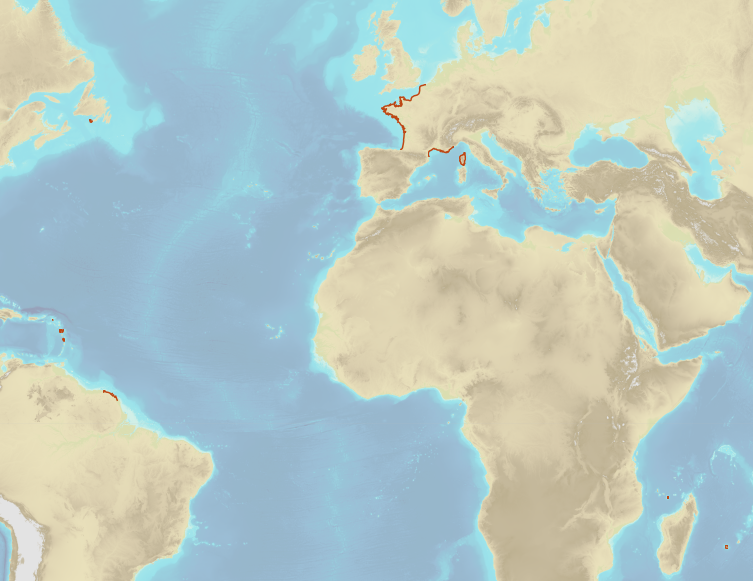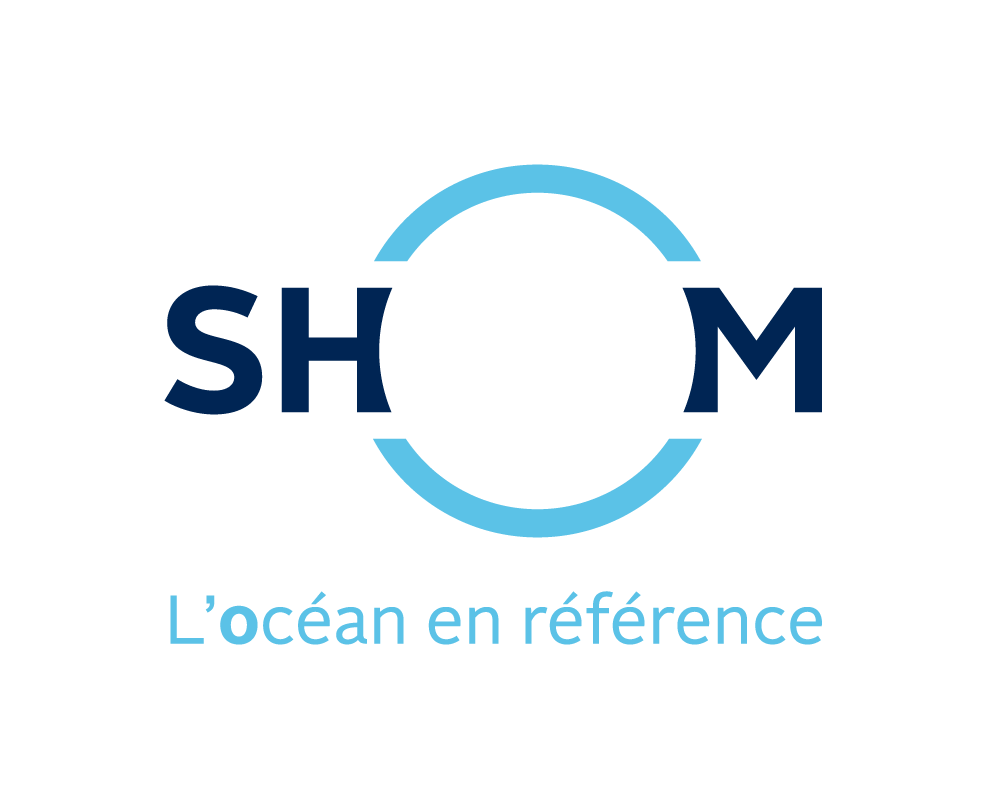boundaries
Type of resources
Available actions
Topics
Keywords
Contact for the resource
Provided by
Years
Formats
Representation types
Update frequencies
Scale
-
In compliance with Article 57 of UNCLOS, the outer limit of the exclusive economic zone (EEZ) is located at 24 nautical miles from the baselines. This limit distinguishes the EEZ from the High Sea. Beyond this limit, an extension of the continental shelf is possible subject to the criterias of Article 76 of UNCLOS. The objects of the theme "Outer limit of the exclusive economic zone" result from Shom computations and are compliant with Article 10 of the French Order No 2016-1687 of 8 December 2016. They are published by decree of the French Republic.
-
The contiguous zone is adjacent to the territorial sea and may not extend beyond 24 nautical miles from the baselines from which the breadth of the territorial sea is measured. The coastal State may exercise the control necessary to: - prevent infringement of its customs, fiscal, immigration or sanitary laws and regulations within its territory or territorial sea; - punish infringement of the above laws and regulations committed within its territory or territorial sea.
-
The United Nations Convention on the law of the sea (UNCLOS) introduced a new definition of the continental shelf which can extend “to the outer edge of the continental margin, or to a distance of 200 nautical miles from the baselines from which the breadth of the territorial sea is measured where the outer edge of the continental margin does not extend up to that distance.” Coastal States can thus have a continental shelf of 200 nautical miles even in the absence of a geomorphological continental shelf, and a continental shelf extending beyond that limit where the presence of certain geomorphological and sedimentary criteria have been recognized by the Commission on the Limits of the Continental Shelf (CLCS). The rights coastal State can exercise over the continental shelf are specified in Part VI of the UNCLOS. These rights are sovereign and exclusive over the seabed and subsoil, for exploration and exploitation of natural mineral, fossil and biological resources. The French authorities also hold competence recognized by the UNCLOS for: - construction, operation and use of artificial islands and installations; - marine scientific research; - issuing consent for the course of any pipeline; - issuing consent for the course of cables installed or used for exploitation of the continental shelf or of its resources.
-
The exclusive economic zone is adjacent to the territorial sea and extends to a maximum distance of 200 nautical miles calculated from the baselines. This is a space in which the coastal State do not practice its entire sovereignty but only the following rights: - sovereign rights over the water column, the bed and subsoil for the purposes of: - exploration, exploitation, conservation and management of natural resources, whether biological or not; - exploration and exploitation of the zone for economic purposes, such as the production of energy from water, currents and wind; - jurisdiction concerning the following fields: - construction and use of artificial islands, facilities and works; - marine scientific research; - protection and preservation of the marine environment. Apart from the rights and obligations of the coastal States cited above, the exclusive economic zone is a space open to the exercise by any other State of the freedoms set down in the United Nations Convention on the law of the sea (UNCLOS) (navigation, overflight, etc.), within the limits set by the Convention.
-
The territorial sea extends from the baselines to a maximum distance of 12 nautical miles, calculated from the baselines. The State has full sovereignty over the bed and subsoil, surface and underlying water column and air space. Sovereignty shall not, however, hinder the right of innocent passage of which the ships of all States benefit in the territorial sea.
-
The "Sovereignty and jurisdiction maritime spaces of France" product contains the areas of sovereignty and jurisdiction maritime spaces of France all around the world.<br /><br /> It is constituted of 2D areas objects split into four categories :<br /> - the territorial sea (from baselines to a distance of 12 nautical miles or to maritime boundaries with neighbouring countries);<br /> - the contiguous zone (from 12 nautical miles to 24 nautical miles from the baselines or to maritime boundaries with neighbouring countries);<br /> - the exclusive economic zone (EEZ) (from 12 nautical miles to 200 nautical miles from the baselines or to maritime boundaries with neighbouring countries);<br /> - the continental shelf over the 200 nautical miles limit (from 200 nautical miles from the baselines to the limits recommended by the Commission on the Limits of the Continental Shelf (CLCS) or to the maritime boundaries with neighbouring countries).<br /> Internal waters, which constitute a space of sovereignty beyond the baselines, are not included in the "Sovereignty and jurisdiction maritime spaces of France" product.<br /> The "Sovereignty and jurisdiction maritime spaces of France" product may not be considered as an enforceable right. Only the “Maritime limits and boundaries” product, that can be displayed and interrogated on the website data.shom.fr (maritime boundaries category) and also downloaded on the French national portal of maritime limits (https://maritimelimits.gouv.fr), may be considered so.<br /><br /> December 2022 version.
-
The combined error grid of the SIO V31 gravity anomaly model (D. T. Sandwell, H. Harper, B. Tozer et al., Gravity field recovery from geodetic altimeter missions, Advances in Space Research, https://doi.org/10.1016/j.asr.2019.09.011) is computed with a method described in a paper submitted to Earth and Space Science (AGU). The model’s extension is North Atlantic.
-
The combined error grid of the SIO V31 gravity anomaly model (D. T. Sandwell, H. Harper, B. Tozer et al., Gravity field recovery from geodetic altimeter missions, Advances in Space Research, https://doi.org/10.1016/j.asr.2019.09.011) is computed with a method described in a paper submitted to Earth and Space Science (AGU). The model’s extension is North Atlantic.
-
In the Law of the Sea, a straight baseline is composed by a loxodrome connecting two points of the low-water line or low-tide elevations if there is a lighthouse or similar permanent infrastructure on them. The conditions to draw such lines are defined in Article 7 of UNCLOS. The straight baselines are part of the baselines of a coastal State below which the internal waters are defined. Those straight baselines, in addition with the normal baseline, compose the inner limit of the territorial sea and are the basis of the computations of the outer limits of other maritime spaces defined by UNCLOS. They are also composed of the closure line for bays and rivers in compliance with Aricles 9 and 10 of UNCLOS. The objects of the theme "Straight baselines" result from Shom computations and are published by decree of the French Republic.
-

French Ministry of Culture / DRASSM – Shom The product "Limit of preventive archeology licence fee" contains the limits for the preventive archeology licence fee (1 nautical mile) as defined in the French Heritage Code. This limit is managed by the Department of Underwater Archeological Research (DRASSM) of the Ministry of Culture. This limit, defined by the Heritage Code at 1 nautical mile from the low-water line, permits to delineate the areas where the licence fee for preventive archeology at sea is applied. In Mainland France in the Gironde estuary, the limit for the preventive archeology licence fee is stopped by the crosswise limit of the sea as defined by the decree of 26 August 1857. In French Guiana, the limit for the preventive archeology licence fee is stopped in Maroni and Oyapock rivers by the crosswise limits of the sea respectively defined the order of 30 January 1991 and the order No 863 of 26 May 1986, until meeting the land boundary which delineates the rivers with the neighbouring States. The product "Limit of preventive archeology licence fee" is to use in addition to the digital product “Maritime Limits and Boundaries” of Shom (French: “Délimitations maritimes”) which represents the limits of the French maritime spaces of sovereignty or jurisdiction through the World. The product “Maritime Limits and Boundaries” (French: “Délimitations maritimes”) can be viewed on data.shom.fr (Maritime boundaries Category) and downloaded on the French national portal of maritime limits (https://maritimelimits.gouv.fr).
 Catalogue Shom
Catalogue Shom